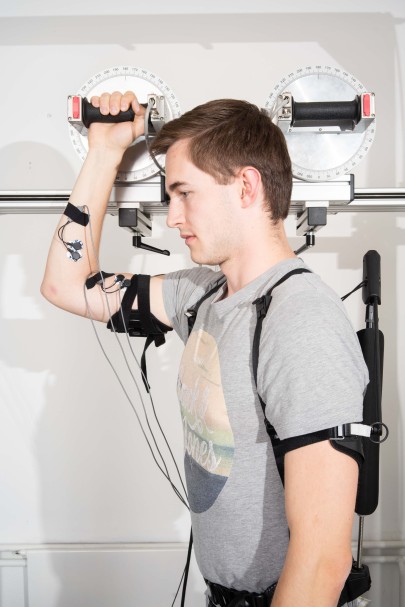Ergonomic Assesment of workload and strain
Backround
The use of technical support systems e.g. passive and active exoskeletons has made it possible to reduce the strain on the working person caused by awkward postures – i.e. static hand-arm positions as well as overhead work – and manual material handling. Whether and to what extent a reduction in stress and strain is achieved by the use of passive exoskeletons at industrial workplaces is only known to a limited extent. There is also a lack of evaluated analysis concepts for individual ergonomic issues related to the use of passive exoskeletons at work.
Aims
- Development of ergonomic concepts for the analysis and evaluation of stress and strain when using passive exoskeletons in the laboratory and in practice
- Acquisition of reliable ergonomic findings on the use of passive exoskeletons at industrial workplaces
- Implementation of the findings in ergonomic evaluation procedures
- Development of guidelines for the introduction and use of passive exoskeletons in practice
Methodic
For biomechanical-physiological problems in laboratory and field studies:
- Motion-stress analysis with the CAPTIV motion capture system
- Motion and pressure analysis with the OpenGo -Moticon sensor soles
For ergonomic problems in laboratory and field studies:
- Work heart rate measurement / analysis (physiological parameter: WHR)
- Surface electromyography (EMG) of selected muscle groups;
- BORG CR-10 Skala (subjective perception of stress and strain)
- Questionnaire according to Corlett-Bishop or Nordic Questionnaire for subjective body segment-based assessment of the load/stress;
For economic problems with a focus on industrial engineering (in practical studies):
- Time analyses based on Method-Time-Measurement (MTM)
- Questionnaire for the subjective recording and analysis of acceptance
Results
Expected results:
- Ergonomic concepts for the analysis and evaluation of the loads and stresses when using passive exoskeletons in the laboratory and in practice;
- Ergonomic findings on the use of passive exoskeletons at industrial workplaces;
- Findings implemented in ergonomic evaluation procedures;
- Guidelines for the introduction and use of passive exoskeletons in practice







